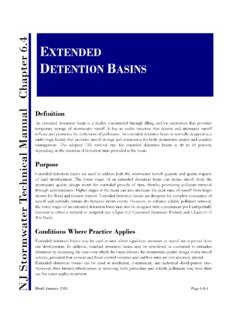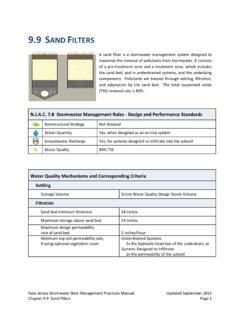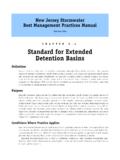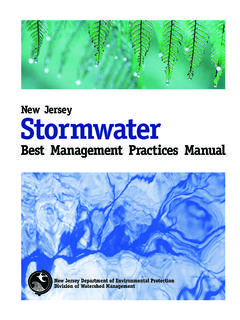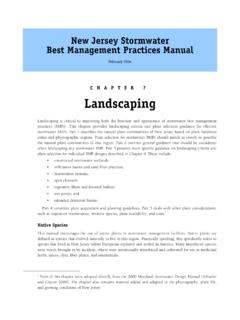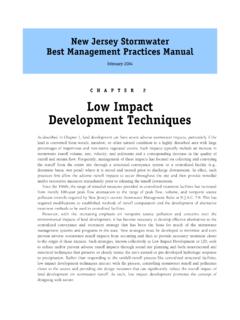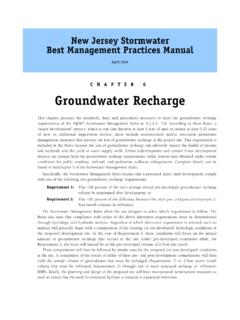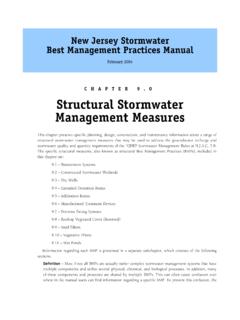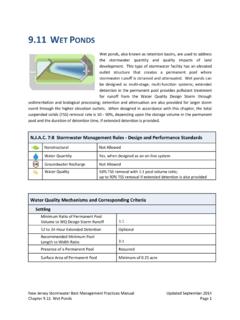Transcription of DRAFT GRASS SWALE - NJ Stormwater.org
1 DRAFT For Comment April 2010 Page XXXXX-1 Definition A GRASS SWALE is a stable turf, parabolic or trapezoidal channel used for water quality or to convey stormwater runoff, which does not rely on the permeability of the soil as a pollutant removal mechanism. The total suspended solids (TSS) removal rate for a GRASS SWALE designed according to this chapter is 50%. Purpose GRASS swales are used to reduce particulate pollutants due to settling and filtration. Adsorption and vegetative uptake can also serve to reduce dissolved pollutants in stormwater runoff.
2 Particulate pollutant removal occurs when the low velocities and shallow depths allow particulate settling and the GRASS blades act to filter runoff from the water quality design storm. For larger storm events, the SWALE can also be used as an alternate to traditional storm sewer system. Conditions Where Practice Applies GRASS swales are best suited to transport and treat stormwater runoff generated from impervious surfaces with small drainage areas. GRASS swales can be used wherever soil conditions and slopes permit the establishment and maintenance of a dense stand of vegetative cover.
3 GRASS swales are typically installed in low gradient lawns, median strips, parking lot islands, unused lot areas, and utility easements, where downstream flow attenuation is provided to control larger storm events. Design Criteria GRASS swales treat the runoff from the water quality design storm and can also be designed as a vegetated conveyance for larger storm events. GRASS swales designed in the following manner can receive credit for 50% TSS removal rate. The SWALE can be trapezoidal or parabolic, with a minimum bottom width of 2 feet and a maximum bottom width of 10 feet.
4 GRASS height shall be established and maintained at 3-6 inches. DRAFT GRASS SWALE DRAFT For Comment April 2010 Page XXXXX-2 The maximum allowable depth in the SWALE is 2 inches for the Water Quality Design storm, using Manning s equation and a Manning s n value of This Manning s n value shall only be used with the Water Quality Design Storm for the design of the GRASS SWALE BMP for TSS removal. The minimum SWALE length is 50 feet. The maximum allowable side slope is 3:1, with a recommended side slope of no more than 4:1.
5 Figure : SWALE Profile The maximum allowable velocity of the Water Quality Design storm is feet per second. There shall be a minimum of 1 foot separating the bottom of the SWALE from the seasonal high water table (SHWT). The minimum longitudinal slope is 2%. This slope may be reduced to if there is a minimum of 2 feet separation from the SHWT and the soil has a field tested permeability rate of at least 1 inch/hr in accordance with the procedures at Appendix E. The maximum longitudinal slope is 10%.
6 GRASS swales must be stable in accordance with the Standard for Grassed Waterways in the Standards for Soil Erosion and Sediment Control in New Jersey. Note: If the channel is being designed only for the purposes of stormwater conveyance, the water quality design/sizing criteria does not apply and the channel shall be designed in accordance with the Standards for Soil Erosion and Sediment Control in New Jersey for stability and capacity.
7 GRASS swales not designed for water quality under this subchapter may still receive credit as a nonstructural stormwater management strategy for the conveyance of stormwater runoff. Additional information on nonstructural stormwater management strategies is available in Chapter XXX. DRAFT For Comment April 2010 Page XXXXX-3 TSS Removal Rates for Different SWALE Configurations: Due to differences in SWALE configurations, the area treated by a SWALE can vary.
8 A list of three configurations to achieve a TSS removal rate of 50% is provided below. 1. A 50 foot or longer SWALE for systems with point discharge. (Figure ) 2. A 200 foot or longer SWALE with distributed discharge. (Figure ) 3. Distributed discharge swales that are less than 200 feet are given 50% TSS removal rate for the length of SWALE upstream of 50 feet. (Figure ) The figures below provide examples of these SWALE configurations and how the inflow areas are collected. The length of a water quality treatment SWALE may change based on the configuration.
9 Figure shows inflow from impervious cover discharging to the upstream point of a SWALE . Since the entire 150 feet of roadway section is collected prior to being treated by the 50 feet of SWALE , a 50% TSS removal rate is provided. Figure : Inflow Area for Systems with Point Discharge Figure depicts a 200 foot portion of roadway where the discharge is distributed along the length of the adjacent SWALE through overland flow. (Note: The inflow area is treated by a SWALE length that varies from 50 to 200 feet for 150 feet of roadway (Stations 0+50 to 2+00).)
10 Based on the research information, the additional treatment provided from Stations 0+50 to 2+00 feet is sufficient to mitigate for the lack of treatment that occurs in the first 50 feet of SWALE to provide a 50% TSS removal rate for the entire 200 feet.) Therefore, in cases where 200 feet of SWALE is provided along a roadway, the entire inflow area will receive a 50% TSS removal rate. DRAFT For Comment April 2010 Page XXXXX-4 Figure : Inflow Area for Distributed Discharge Figure below shows that from 50 to 150 feet, the inflow area passes through a minimum of 50 feet.
